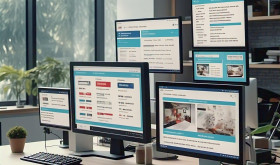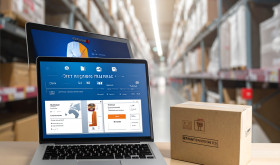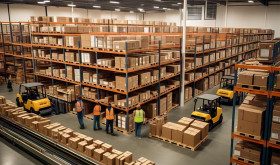
The industrial manufacturing sector forms the core of the world economy, creating products ranging from cars and electronic devices to industrial equipment and building supplies. As supply chains in manufacturing become more intricate and customer expectations grow, moving raw materials and finished products has turned into a key advantage. This is where the Transport Management System comes in—a digital tool that’s causing a revolution in logistics for manufacturers, enabling them to tackle today’s economic hurdles with flexibility and smarts.
The Current Manufacturing Logistics Scene
Companies that make things today face a bunch of logistics challenges: unpredictable supply chains, changing shipping prices, not enough workers, and customers who want things fast and want to know where their stuff is. Global disruptions, like political troubles or health crises, can mess up the supply chain, slowing down production and cutting into profits. In this tough situation, being able to handle shipping well isn’t just about saving money—it’s key to keeping the business running and making customers happy.
What’s a Transport Management System?
A transport management system is software that helps companies to plan, execute, and optimise how goods move—by land, sea, or air—both inbound and outbound. It brings together logistics operations, makes routine tasks automatic, and lets you see every stage of transport in real time. For manufacturers, a transport management system isn’t just a tool; it’s a strategy that links production, warehousing, and distribution into one smooth process.
Key Features of a Transport Management System for Manufacturers
- Centralised Logistics and Freight Management
- Transport management system platforms bring all transport activities—picking carriers, managing rates, booking, and paperwork—into one system, which gets rid of separate departments and handmade mistakes.
- Real-Time Shipment Tracking and Visibility
- Manufacturers get live updates on where their shipments are and how they’re doing. This helps them act fast when problems come up and tell customers when to expect deliveries.
- Automated Order and Yard Management
- A transport management system makes work easier by automating transport orders and keeping track of trailers in factory yards. This cuts down on holdups and keeps things moving.
- Advanced Reporting and Analytics
- Transport management system tools give useful info about how carriers perform, how long trips take, and what they cost. This lets manufacturers base their choices on solid data.
- Multi-Modal and Scalability Support
- New transport management systems work with all modes of transport—truckload, LTL, rail, intermodal, and ocean. This lets manufacturers grow their operations as their business gets bigger.
How Transport Management System Tackles Economic Hurdles
- Cost Control and Optimisation
Moving goods eats up a big chunk of money for makers. Transport management system tools map out the best routes, pack trucks fuller, and scout for the cheapest carriers. This cuts down on empty trips and squeezes more use out of each vehicle. As a result, companies save on gas and shrink their carbon footprint.
- Navigating Supply Chain Volatility
When worldwide supply chains face sudden hiccups, seeing what’s happening now and guessing what’s next becomes crucial. A transport management system helps manufacturers spot disruption, reroute shipments, and maintain production schedules even when suppliers or shippers hit snags.
- Reducing Human Error and Manual Work
Manual logistics processes are slow and prone to errors. Transport management systems have an impact on data entry, route planning, and document creation by automating them. This cuts down on costly mistakes and allows staff to focus on more valuable work.
- Enhancing Customer Satisfaction
Accurate deliveries play a crucial role in keeping customers. TMS systems let manufacturers give reliable delivery estimates, live tracking, and quicker answers to customer questions, which builds trust and keeps customers coming back.
- Supporting Sustainability Initiatives
Sustainability now ranks as a top concern for manufacturers. Transport management systems make routes and loads more efficient to cut down on emissions, help bring in electric vehicles, and give data to report on sustainability.
Integration with Modern Technologies
Several tech trends are shaping the future of transport management systems:
- AI and Machine Learning: These tools help predict demand, find the best routes, and manage risks.
- IoT and Telematics: These technologies monitor vehicles, cargo, and drivers in real time to boost safety and efficiency.
- Blockchain: This creates unchangeable records for shipment papers, which builds trust and makes the supply chain more transparent.
- Cloud and Mobile Access: These give control over logistics operations from anywhere, at any time. They support remote work and real-time collaboration.
Case Example: Transport Management System in Action
Think about a big company that makes things all over the world. They were paying more to ship stuff and often had late deliveries. When they started to use a transport management system, the company:
- Put all transportation data in one place, giving a full view from start to finish.
- Picked carriers and set rates, cutting freight costs by 15%.
- Tracked shipments in real time to cut delivery delays by 30%.
- Made it easier for production, warehouse, and logistics teams to talk to each other, boosting overall productivity.
These changes didn’t just save money. They also made customers happier and made the supply chain stronger.
Implementation Considerations
While the benefits of a transport management system are clear, manufacturers must consider:
- Initial Investment: Implementing a transport management system costs money up front for software, integration, and training. But the return on investment comes fast because of savings and better efficiency.
- Change Management: Success hinges on getting staff on board and training them well to make the most of the system.
- Integration: A transport management system should work with ERP, WMS, and other supply chain systems to provide the most value.
Conclusion
In manufacturing, where productivity, resilience, and customer satisfaction are key, a transport management system isn’t just nice to have—it’s a must for strategy. By bringing logistics operations together, doing routine jobs, and letting you see what’s happening right now, transport management systems help manufacturers keep costs down, navigate supply chain disruptions, and deliver superior service.
As the industry deals with ongoing economic challenges, those who invest in advanced transport management systems will be in the best position to do well—turning their logistics from something that costs money into something that gives them an edge over others.










